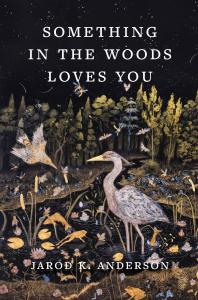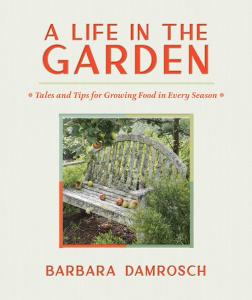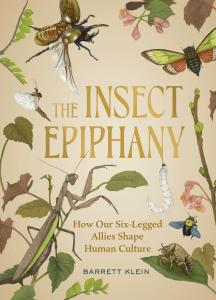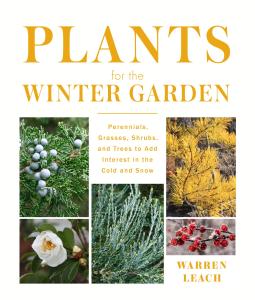New Releases for Fall 2024
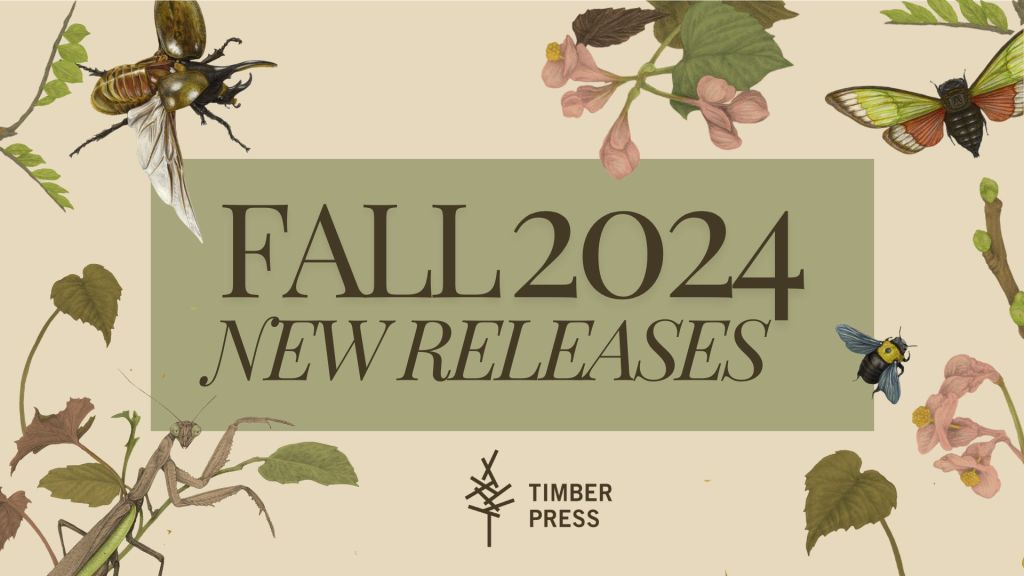
Upcoming books from Timber Press!
An inspiring blend of nature writing and memoir that explores nature’s crucial role in our emotional and mental health
Bats can hear shapes, plants can eat light, and bees can dance maps. When his life took him to a painfully dark place, the poet behind The CryptoNaturalist, Jarod K. Anderson, found comfort and redemption in these facts and the shift in perspective that comes from paying a new kind of attention to nature.
Something in the Woods Loves You tells the story of the darkest stretch of a young person’s life, and how deliberate and meditative encounters with plants and animals helped him see the light at every turn. Ranging from optimistic contemplations of mortality to appreciations of a single mushroom, Anderson has written a lyrical love letter to the natural world and given us the tools to see it all anew.
A genre-bending blend of naturalism, memoir, and social manifesto for rewilding the city, the self, and society.
“Brown lives far from any conventional battlefield, but he is surrounded by the wreckage of a different war, and he, too, finds hope in cultivating the ruins of nature…A Natural History of Empty Lots is less a departure from the nature writing tradition than a welcome addition to its edgelands.” —New York Review of Books
A Natural History of Empty Lots is a genre-defying work of nature writing, literary nonfiction, and memoir that explores what happens when nature and the city intersect.
During the real estate crash of the late 2000s, Christopher Brown purchased an empty lot in an industrial section of Austin, Texas. The property—abandoned and full of litter and debris—was an unlikely site for a home. Brown had become fascinated with these empty lots around Austin, so-called “ruined” spaces once used for agriculture and industry awaiting their redevelopment. He discovered them to be teeming with natural activity, and embarked on a twenty-year project to live in and document such spaces. There, in our most damaged landscapes, he witnessed the remarkable resilience of wild nature, and how we can heal ourselves by healing the Earth.
Beautifully written and philosophically hard-hitting, A Natural History of Empty Lots offers a new lens on human disruption and nature, offering a sense of hope among the edgelands.
A thought-provoking scientific narrative investigating ice patch archaeology and the role of glaciers in the development of human culture.
Glaciers figure prominently in both ancient and contemporary narratives around the world. They inspire art and literature. They spark both fear and awe. And they give and take life. In The Age of Melt, environmental journalist Lisa Baril explores the deep-rooted cultural connection between humans and ice through time.
Thousands of organic artifacts are emerging from patches of melting ice in mountain ranges around the world. Archaeologists are in a race against time to find them before they disappear forever. In entertaining and enlightening prose, Baril travels from the Alps to the Andes, investigating what these artifacts teach us about climate and culture. But this is not a chronicle of loss. The Age of Melt explores what these artifacts reveal about culture, wilderness, and what we gain when we rethink our relationship to the world and its most precious and ephemeral substance—ice.
“Drawing on a lifetime of organic gardening, Barbara Damrosch collects her lessons learned and wisdom gained into an easy-to-read-and-enjoy overview of kitchen gardening. For the new gardener, there is encouragement on top of nuts-and-bolts advice. For every gardener, there is inspiration to face the challenges inherent in a life deeply rooted in and fed from the garden.” —American Gardener
In A Life in the Garden, horticultural icon Barbara Damrosch imparts a lifetime of wisdom on growing food for herself and her family. In writing that’s accessible, engaging, and elegant, she welcomes us to garden alongside her. Personal, thoughtful, and often humorous, this book offers practical DIY insights that will delight gardeners, cooks, and small-scale farmers. With a personal and sometimes irreverent tone, Barbara expresses the pleasure she takes in gardening, the sense of empowerment she finds in it, and the importance of a partnership with the real expert: nature.
From entomologist Barrett Klein comes a buzz-worthy exploration of the many ways insects have affected human society, history, and culture
As heard on Science Friday.
Insects surround us. They fuel life on Earth through their roles as pollinators, predators, and prey, but rarely do we consider the outsize influence they have had on our culture and civilization. Their anatomy and habits inform how we live, work, create art, and innovate. Featuring nearly 250 color images—from ancient etchings to avant-garde art, from bug-based meals to haute couture—The Insect Epiphany proves that our world would look very different without insects, not just because they are crucial to our ecosystems, but because they have shaped and inspired so many aspects of what makes us human.
In the bitter winds of autumn 1963, Tove Jansson, helped by Brunström, a maverick fisherman, raced to build a cabin on a treeless island in the Gulf of Finland. The island was Klovharun, where for thirty summers Tove and her beloved partner, the visual artist, Tuulikki “Tooti” Pietilä, lived, painted, and wrote, energized by the solitude and shifting seascapes. The island’s flora, fauna, and weather patterns provided deep inspiration which can be seen reflected in all of Jansson’s work, most famously in her bestselling novel The Summer Book and her longstanding comic strip and novels for children, Moomin. Tove’s signature spare, quirky prose, and Tooti’s subtle ink washes and aquatints combine to form a work of meditative beauty, a chronicle of living peacefully in nature and observing the island’s ecology and character. Notes from an Island is both a work of artistic collaboration and an homage to the deep love the two women shared. One feels as if Jansson’s journal, with Tooti’s sketches tucked inside, has been unearthed like a treasure from under a pile of old quilts in the back of their rustic cabin.
Praise for the essay, “The Island”
“At once a short story, an essay, and a prose poem, ‘The Island’ reads both like a sketch for The Summer Book and a vignette of Klovharun … the text seems to change following mysterious tides from a timeless present to an urgent past.” —Hernan Diaz, finalist for the Pulitzer Prize
Praise for Tove Jansson
“It could be said that everything she wrote is, in one way or another, about the creative interactions between art and reality or art and nature.”—The Guardian
“Her style is not at all ‘poetic’—quite the contrary. It is prose of the very highest order; it is pure prose. Through its quiet clarity we see unreachable depths, threatening darkness, promised treasures.”—Ursula K. LeGuin, The Guardian
“Tove Jansson was a genius, a woman of profound wisdom and great artistry.”—Philip Pullman
“It’s hard to describe the astonishing achievement of Jansson’s artistry.”—Ali Smith
Black Flora is the first book to feature profiles of contemporary Black experts innovating in the world of flowers. Author and longtime gardener, Teresa Speight, offers a beautiful intersection of flowers and community. This book is a homecoming, one that unearths the floral legacies of the past and present, while providing a source of inspiration for younger generations of plant-lovers seeking examples of successful Black floral artists and entrepreneurs.
With photos and insights from over 20 growers, florists, and designers from around the US, each with a deep reverence for nature, Black Flora showcases a range of floral expertise. And as visionary horticulturalist and garden historian, Abra Lee, reflects in her foreword, the community represented in Black Flora has an important significance both today, and in garden history.
Both a celebration of now and a vision for the future, Black Flora honors floriculture’s creative vanguard.
Though many plants go dormant in wintry months, there are many inspiring cultivars and varieties that hold their interest through the cold and snow, including brightly colored twigs, buds, and berries, dazzling winter flowers and dried seed pods. Plants for the Winter Garden extends the possibilities for the cold-climate gardener and provides invaluable insight that will make any garden thrive during the cold season.Plantsman Warren Leach shares expertise and techniques perfected over thirty years of gardening in frigid eastern Massachusetts. Discover how to incorporate structural elements like stone walls, paths, and hardy containers that keep gardens intriguing when covered with snow; accentuate plant shapes that hold their form year-round; site and prune evergreens for maximum effect; and showcase trees with textured or colorful bark that stand out in gray months. And much more!
Identify and discover the inner lives of birds with this easy to use full-color guidebook.
Birds of Arizona and New Mexico is a comprehensive field guide to commonly found birds in the American Southwest.
Authors Melissa Fratello and Steven Prager speak to a new generation of birders, offering a unique perspective and approach to birding that prioritizes accessibility and inclusion. They also cover the region’s unique issues, such as birding on tribal land, and birding along the Southern Border.
Birds of Arizona and New Mexico will delight both experienced and aspiring birders with:
·Coverage of Arizona, New Mexico, and their border regions
·Illustrated descriptions of nearly 400 bird species
·800+ spectacular photographs of relevant plumages and birds in flight
·Individual range maps showing seasonal and migratory patterns
·And much more!

